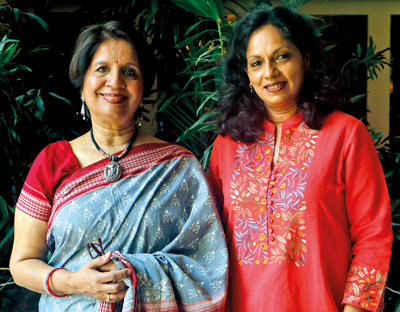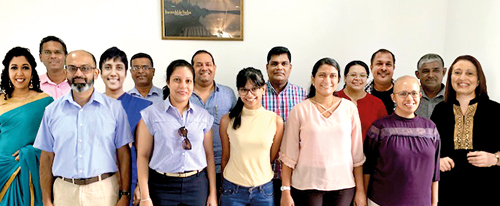Sounds of South Asia to bring ‘light in the darkness’

Working together: Ambassador Nirupama Rao and SOSL Chairperson Sharmini Wettimuny. Pic by Priyanka Samaraweera
As the sun sets at the Attari-Wagah border between India and Pakistan, the two countries execute a quick parade. Every day, a border closing ceremony involves soldiers in full regalia from both sides marching in a choreographed demonstration that includes the highest kicks you have ever seen. Spectators applaud, but when tensions run high in the region, eyes turn this way. It is why, one day, Ambassador Nirupama Rao would like to see the South Asian Symphony Orchestra (SASO) play there.
“I want this orchestra to play at the Wagah border, I want the music to provide a contrast to what happens there, to be a counterpoint, if you will,” says the diplomat who served as India’s Foreign Secretary from 2009 to 2011. A former High Commissioner of India to Sri Lanka, Nirupama is now officially retired but diplomacy is in her blood – and so is music.With this orchestra, the two are now beautifully intertwined.
“Music is a way of making sense of the world, and of what South Asia is today. We are aware of the divisions that separate us, the partitions that belong to our history and the tensions that tend to create barriers between all the nations in the region,” she told the Sunday Times during a recent visit to Colombo.
In this context, Nirupama believes an orchestra serves as the perfect analogy for regional ties, an audible demonstration of what harmony is possible here. To extend the analogy even further, both the orchestra and the region are greater than the sum of their parts, she says. In a time when we seem always on the brink of conflict, Nirupama is hopeful that the arts can be a voice for the vast majority who prefer to live in peace.
Determined to realise this vision, Nirupama and her husband Sudhakar Rao formed the trust, the South Asian Symphony Foundation in July 2018 in Bangalore, and through it they have raised funds for the first ever orchestra to include members from all the 8 countries in the South Asian Association for Regional Cooperation (SAARC). The orchestra is to be called Chiragh. Meaning ‘light in the darkness’, Chiragh is also the title of their upcoming concert, an entirely Indian-funded initiative on April 26, at the National Centre for the Performing Arts in Mumbai.
The concert will feature Houston-based Viswa Subbaraman as the conductor of the SASO, while New York-based Sri Lankan soprano Tharanga Goonetilleke will be the solo vocalist. Kabir Bedi will be the narrator. Forming the core will be members of the Symphony Orchestra of Sri Lanka – 14 of whom will be travelling to Mumbai to perform at the inaugural concert.
“The Symphony Orchestra of Sri Lanka (SOSL) is the oldest orchestra in the region and is currently in its 62nd year of performance,” Sharmini Wettimuny, Chairperson of SOSL told the Sunday Times, explaining that a first step was taken when India and Sri Lanka collaborated to mark the 70th year of independence in both countries with the concert Music Beyond Borders in February 2018.
Tamara Holsinger, a cellist with SOSL has performed alongside Indian musicians many times in the past, and says the experience has always been rewarding both musically and personally.
Now she is looking forward to a more ambitious undertaking: “Performing with musicians from the entire SAARC region, as well as the South Asian Diaspora will be a new experience for me, and one that I feel will be incredibly enriching not only in terms of interacting and collaborating with such a diverse group, but also in my growth as a musician, as well as the personal connections that are so important and which inevitably follow from such a collaboration,” she said.
Two original works by South Asian composers have been commissioned for Chiragh, and will be the first of an estimated 30. “Hamsafar”: A Musical Journey through South Asia – is a work specially commissioned by Classical Movements’ Eric Daniel Helms New Music Program. It weaves together a tapestry of traditional and popular music from seven countries in the South Asia region, explains Nirupama, adding that the suite opens with Aiyandiye, a melody from Sri Lanka and then goes on to embrace the music of Bangladesh, Nepal, India and Afghanistan. It will be a unique and beautiful tribute to the diversity in the region.
The orchestra will also incorporate indigenous instruments, and Sharmini is excited about the possibility of Sri Lankan drums sounding on the stage in the future. While the orchestra will reflect the space in which it is being performed, Nirupama says they are not afraid of exploring non-indigenous cultural and artistic traditions.
Citing the popularity of rap and hip hop in the Indian film industry, Nirupama says: “There is a lot of Western music coming in and so the time is ripe for opening our doors and windows a little more to influences from outside. Our traditions are strong, we will not be blown off our feet and I think that confidence has emerged now.”
For Nirupama, incorporating melodies from across the region feels like an essential step toward popularizing the music. One suspects, the inspiring stories of the musicians involved will take care of the rest.
Among them is Arson Fahim, a young Afghan who says that hearing a piano played for the first time opened a door for him as a child after he returned from years in a refugee camp in Pakistan. Another is Shing Yan. Hailing from Nepal, the violinist is a Sherpa and belongs to the tribe famed for their ability to conquer the highest mountains in the world.
Others include members of the Sri Lankan armed forces (including one policeman) who served during the war. “In this way, this orchestra bridges war and peace,” says Nirupama smiling, adding that musicians across the region face similar challenges: most can never hope to find funding to perform full-time, and infrastructure, training and other facilities are lacking in the countries where they live and work.
However, their passion and dedication shine through. “We want to realise the power of orchestral music to bring together people,” concludes Sharmini on a reflective note. “In an orchestra, you have to listen to each other and work as one unit. There is no individual glory or performance. We work together. I would love to see this effort highlight the values and life lessons you learn as a human being, simply by being part of an orchestra.”
| The Lankan performers | |
 Violin: Nilupul Silva (Leader of the SOSL) & Soundarie David Rodrigo; Viola: Avanti Perera and Mangala Abeysekera; Cello: Dushy Perera, Tamara Holsinger; Double Bass: Andrea Leitan; Flute: Dilrukshi Wiratunga; Oboe: Hasitha Pathirana; Bassoon: Nalaka Perera; French Horn: Saman Kularatne; Trumpet : Naveen Fernando & Kalum Nishyantha; Trombone: Nisantha Premalal and Timpani: Neomal Weerakoon |


